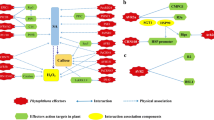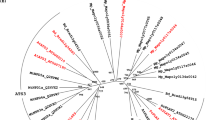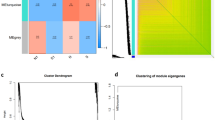Abstract
Experimental data obtained in this study had shown the involvement of A. thaliana immunophilin genes At2g16600, At4g33060, and At5g48570 in plant defense responses to the Xanthomonas campestris invasion. We had found not only that the expression levels of these genes changed upon bacterial infection, but also that the plant’s resistance to the pathogen was increased if the expression levels of the immunophilin genes were elevated in the host cells.
Similar content being viewed by others
References
Knight, H. and Knight, M.R., Abiotic stress signalling pathways: specificity and cross-talk, Trends Plant Sci., 2001, vol. 6, no. 6, pp. 262–267.
Chen, W., Provart, N.J., Glazebrook, J., et al., Expression profile matrix of Arabidopsis transcription factor genes suggests their putative functions in response to environmental stresses, Plant Cell, 2002, vol. 14, no. 3, pp. 559–574.
Sekhar, K., Priyanka, B., Reddy, V.D., and Rao, K.V., Isolation and characterization of a pigeonpea cyclophilin (CcCYP) gene, and its over-expression in Arabidopsis confers multiple abiotic stress tolerance, Plant Cell Environ., 2010, vol. 33, no. 8, pp. 1324–1338.
Hou, S., Yang, Y., and Zhou, J.M., The multilevel and dynamic interplay between plant and pathogen, Plant Signal Behav., 2009, vol. 4, no. 4, pp. 283–293.
Schiene-Fischer, C. and Yu, C., Receptor accessory folding helper enzymes: the functional role of peptidyl prolyl cis/trans isomerases, FEBS Lett., 2001, vol. 495, nos. 1–2, pp. 1–6.
Hur, S. and Bruice, T.C., The mechanism of cis-trans isomerization of prolyl peptides by cyclophilin, J. Am. Chem. Soc., 2002, vol. 124, no. 25, pp. 7303–7313.
Shaw, P.E., Peptidyl-prolyl isomerases: a new twist to transcription, EMBO Rep., 2002, vol. 3, no. 6, pp. 521–526.
Vespa, L., Vachon, G., Berger, F., et al., The immunophilin-interacting protein AtFIP37 from Arabidopsis is essential for plant development and is involved in trichome endoreduplication, Plant Physiol., 2004, vol. 134, no. 4, pp. 1283–1292.
Cho, E.K., Lee, Y.K., and Hong, C.B., A cyclophilin from Griffithsia japonica has thermoprotective activity and is affected by CsA, Mol. Cells, 2005, vol. 20, no. 1, pp. 142–150.
Hajheidari, M., Abdollahian-Noghabi, M., Askari, H., et al., Proteome analysis of sugar beet leaves under drought stress, Proteomics, 2005, vol. 5, no. 4, pp. 950–960.
Mahfouz, M.M., Kim, S., Delauney, A.J., and Verma, D.P., Arabidopsis target of rapamycin interacts with raptor, which regulates the activity of S6 kinase in response to osmotic stress signals, Plant Cell, 2006, vol. 18, no. 2, pp. 477–490.
Chen, A.P., Wang, G.L., Qu, Z.L., et al., Ectopic expression of ThCYP1, a stress-responsive cyclophilin gene from Thellungiella halophila, confers salt tolerance in fission yeast and tobacco cells, Plant Cell Rep., 2007, vol. 26, no. 2, pp. 237–245.
Kielbowicz-Matuk, A., Rey, P., and Rorat, T., The abundance of a single domain cyclophilin in Solanaceae is regulated as a function of organ type and high temperature and not by other environmental constraints, Physiol. Plant, 2007, vol. 131, no. 3, pp. 387–398.
Laxa, M., Konig, J., Dietz, K.J., and Kandlbinder, A., Role of the cysteine residues in Arabidopsis thaliana cyclophilin CYP20-3 in peptidyl-prolyl cis-trans isomerase and redox-related functions, Biochem. J., 2007, vol. 401, no. 1, pp. 287–297.
Liu, J., Elmore, J.M., Fuglsang, A.T., et al., RIN4 functions with plasma membrane H+-ATPases to regulate stomatal apertures during pathogen attack, PLoS Biol., 2009, vol. 7, no. 6, p. e1000139.
Meiri, D., Tazat, K., Cohen-Peer, R., et al., Involvement of Arabidopsis ROF2(FKBP65) in thermotolerance, Plant. Mol. Biol., 2010, vol. 72, nos. 1-2, pp. 191–203.
Park, S.C., Lee, J.R., Shin, S.O., et al., Purification and characterization of an antifungal protein, C-FKBP, from Chinese cabbage, J. Agric. Food Chem., 2007, vol. 55, no. 13, pp. 5277–5281.
Godoy, A.V., Lazzaro, A.S., Casalongue, C.A., and Segundo, B.S., Expression of Solanum tuberosum ciclophilin gene is regulated by fungal infection and abiotic stress conditions, Plant Sci., 2000, vol. 152, pp. 123–134.
Kong, H.Y., Lee, S.C., and Hwang, B.K., Expression of pepper ciclophilin gene is differentially regulated during the pathogen infection and abiotic stress conditions, Physiol. Mol. Plant Pathol., 2001, vol. 59, pp. 189–199.
He, P., Chintamanani, S., Chen, Z., et al., Activation of a COI1-dependent pathway in Arabidopsis by Pseudomonas syringae type III effectors and coronatine, Plant J., 2004, vol. 37, no. 4, pp. 589–602.
Romano, P.G., Horton, P., and Gray, J.E., The Arabidopsis cyclophilin gene family, Plant Physiol., 2004, vol. 134, no. 4, pp. 1268–1282.
Aumuller, T., Jahreis, G., Fischer, G., and Schiene-Fischer, C., Role of prolyl cis/trans isomers in cyclophilin-assisted Pseudomonas syringae AvrRpt2 protease activation, Biochemistry, 2010, vol. 49, pp. 1042–1052.
Wesley, S.V., Helliwell, C.A., Smith, N.A., et al., Construct design for efficient, effective and high-throughput gene silencing in plants, Plant J., 2001, vol. 27, no. 6, pp. 581–590.
Gleave, A., A versatile binary vector system with a T-DNA organisational structure conducive to efficient integration of cloned DNA into the plant genome, Plant Mol. Biol., 1992, vol. 20, no. 6, pp. 1203–1207.
Chen, P.-Y., Wang, C.-K., Soong, S.-C., and To, K.-Y., Complete sequence of the binary vector pBI121 and its application in cloning T-DNA insertion from transgenic plants, Mol. Breed., 2003, vol. 11, no. 4, pp. 287–293.
Lee, M. and Yang, Y., Transient expression assay by agroinfiltration of leaves, in Arabidopsis Protocols, Salinas, J. and Sanchez-Serrano, J., Eds., New York: Humana, 2006, vol. 323, pp. 225–229.
Swanson, J., Kearney, B., Dahlbeck, D., and Staskawicz, B., Cloned avirulence gene of Xanthomonas campestris pv. vesicatoria complements spontaneous race-change mutants, MPMI, 1988, vol. 1, pp. 5–9.
Livak, K.J. and Schmittgen, T.D., Analysis of relative gene expression data using real-time quantitative PCR and the 2(-Delta Delta C(T)) method, Methods, 2001, vol. 25, no. 4, pp. 402–408.
Author information
Authors and Affiliations
Corresponding author
Additional information
Original Russian Text © M.V. Mokryakova, G.V. Pogorelko, S.A. Bruskin, E.S. Piruzian, I.A. Abdeeva, 2014, published in Genetika, 2014, Vol. 50, No. 2, pp. 157–166.
Rights and permissions
About this article
Cite this article
Mokryakova, M.V., Pogorelko, G.V., Bruskin, S.A. et al. The role of peptidyl-prolyl cis/trans isomerase genes of Arabidopsis thaliana in plant defense during the course of Xanthomonas campestris infection. Russ J Genet 50, 140–148 (2014). https://doi.org/10.1134/S1022795414020100
Received:
Published:
Issue Date:
DOI: https://doi.org/10.1134/S1022795414020100




